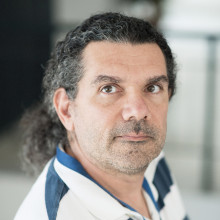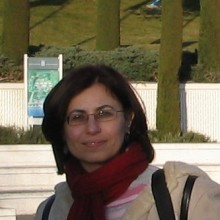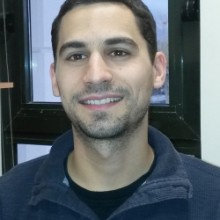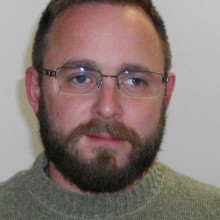To: 07/10/2020 14:00
My research revolves around soft, room temperature materials with a particular interest in the way microscopic interactions, especially non-covalent ones, dictate macroscopic properties. I shall focus on two bio-inspired examples of projects in which physics may provide an in-depth understanding of use to biology and materials science.
Typically, materials exhibit a trade-off between stiffness and extensibility, ultimately limiting the energy density that can be absorbed before fracture. For example, in polymer networks, an increase in cross-link density leads to enhanced stiffness, but compromised extensibility. Dynamic reformable bonds and complex network topologies, such as interpenetrating networks, have been used to circumnavigate this issue in dry and hydrated environments. Inspired by and transferring the chemistry of marine mussels, we present a dry, thermoset, single network that circumvents this inherent trade-off of stiffness and extensibility by incorporating sacrificial, reversible, iron-catecholate cross-links into a loosely covalently linked network.1,2 We attribute the enhancement of mechanical properties to the cooperative effects of the increased cross-link density and the chain-restricting ionomeric nanodomains the iron-catecholate complexes form. We will discuss the effects of moisture, oxidation, and future chemistry variations in order to understand the physics of the system.
Healthy cells, as well as cells under stress and disease, are known to form membrane-less organelles. Many of the participating biomacromolecules are intrinsically-disordered, low-complexity proteins that highly resemble polymers. One of the current hypotheses is that such organelles are formed due to proteins undergoing liquid-liquid phase separation to a dense phase and a dilute phase under certain conditions of temperature, pH, salt and protein concentrations. By focusing on low-complexity intrinsically-disordered protein and their corresponding peptides and peptoids that we plan to design, we aim to study quantitatively the effect of their zwitterionic nature, hydrogen bonding, inclusion of hydrophobic side chains and pi-cation interactions on liquid-liquid phase separation by measuring complete phase diagrams in vitro. By using techniques and theory from polymer physics to examine the heteropolymer phase separation and choosing amino acids and post-translational modifications of biological interest, we hope to provide a physical basis of understanding of interest to biology.
[1] Filippidi, E. et al, Science, 358, 6362, 502-505 (2017)
[2] Cristiani, T. R. et al, Macromolecules, 53, 10, 4099-4109 (2020)
Position Description
«Νανοκρυστάλλοι για εφαρμογές φωτονικής: σύνθεση και χαρακτηρισμός»
Νανοκρύσταλλοι είναι κρυσταλλικά στερεά με διαστάσεις μερικών νανομέτρων. Λόγω του μικρού τους μεγέθους παρουσιάζουν ενδιαφέρουσα συμπεριφορά, όπως η ρύθμιση του ενεργειακού χάσματος από το μέγεθος των νανοκρυστάλλων. Ως ημιαγωγοί, προσφέρουν υψηλές κβαντικές αποδόσεις φωταύγειας, που σε συνδυασμό με το στενό φασματικό εύρος εκπομπής, τους καθιστά ελκυστικούς για χρήση σε εφαρμογές φωτισμού, οθόνες κλπ. Το ερευνητικό πεδίο της μεταπτυχιακής εργασίας αφορά στην ανάπτυξη νέων ανόργανων νανοκρυστάλλων (π.χ. αλογονούχοι περοβσκίτες) και στην κατανόηση της φυσικής τους συμπεριφοράς για βελτιωμένες οπτικές ιδιότητες. Θα επικεντρωθείτε σε νανοκρυστάλλους, των οποίων μπορεί να μεταβληθεί εύκολα η χημική σύσταση, προσφέροντας έτσι φωταύγεια σε όλο το ορατό φάσμα με στόχο τη χρήση τους ως αποδοτικοί φωτοδιόδοι εκπομπής φωτός (LEDs). Ο/Η υποψήφιος θα εκπαιδευτεί σε μεθοδολογίες παρασκευής νανοϋλικών, ενώ θα αποκτήσει γνώσεις για τον χαρακτηρισμό των περίπλοκων φυσικοχημικών ιδιοτήτων τους. Επιπλέον, θα έχει την ευκαιρία να διευρύνει την επιστημονική του γνώση μέσω υφιστάμενων συνεργασιών με Ακαδημαϊκά Ιδρύματα εντός και εκτός της Ελλάδας.
Για το πλήρες κείμενο της πρόσκλησης ακολουθήστε τον σύνδεσμο 'Related Documents'
Required Qualifications
- Πτυχίο Σχολής Θετικών Επιστημών (π.χ. Φυσικής/Χημείας/ Επιστήμης Υλικών κ.α.) ή συναφών ειδικοτήτων Πολυτεχνικής Σχολής
- Άριστη γνώση της Αγγλικής γλώσσας.
Desirable Qualifications
Γνώσεις στην ανάλυση και αξιολόγηση πειραματικών δεδομένων με χρήση πακέτων λογισμικού
Application Procedure
Στο φάκελο υποβολής της πρότασης θα πρέπει να εμπεριέχονται τα ακόλουθα:
- Αίτηση (form Greek στην αριστερή στήλη) με αναφορά στον κωδικό της θέσης και στο όνομα του προγράμματος
- Αναλυτικό Βιογραφικό Σημείωμα
- Ευκρινή φωτοαντίγραφα τίτλων σπουδών
- Επιστολή όπου περιγράφονται τα επιστημονικά ενδιαφέροντα του υποψηφίου
- Αναλυτικές βαθμολογίες
- Πρόσφατη (για το ακαδημαϊκό έτος 2020 – 2021) βεβαίωση σπουδών
- Δύο συστατικές επιστολές που θα αποσταλούν απευθείας στον Διευθυντή Ερευνών ΙΗΔΛ, Δρ Α. Λάππα (lappas@iesl.forth.gr) και στο ΙΗΔΛ-ΙΤΕ (hr@iesl.forth.gr).
ΥΠΟΒΟΛΗ ΠΡΟΤΑΣΕΩΝ
Οι ενδιαφερόμενοι καλούνται να υποβάλουν τις αιτήσεις τους και όλα τα απαραίτητα δικαιολογητικά, ηλεκτρονικά στη διεύθυνση hr@iesl.forth.gr με κοινοποίηση (cc): στον Δρ Α. Λάππα (lappas@iesl.forth.gr). Οι αιτήσεις θα πρέπει να αποσταλούν με την ένδειξη: «Αίτηση στο πλαίσιο του προγράμματος INNOVATION-EL, της πρόσκλησης εκδήλωσης ενδιαφέροντος με Α.Π. … και κωδικό θέσης … » (όπως αυτός αναφέρεται στον Πίνακα του Παραρτήματος).
Appointment Duration
10 μήνεςPosition Description
- Πειράματα και μετρήσεις όπως απαιτείται από το έργο (π.χ. φασματοσκοπικές μετρήσεις δειγμάτων καυσίμων και σχετικών χημικών ενώσεων, κατασκευή και/ή επισκευές σχετικών διατάξεων, κ.α.)
- Ανάλυση των πειραματικών αποτελεσμάτων (π.χ. με χρήση υφιστάμενων προγραμμάτων επεξεργασίας ή με ανάπτυξη νέων όπου απαιτείται)
- Διάχυση των αποτελεσμάτων του έργου (π.χ. μέσω δημοσιεύσεων σε επιστημονικά περιοδικά, παρουσιάσεων σε συνέδρια, αναρτήσεων σε κοινωνικά δίκτυα ή websites, κ.α.)
- Οποιαδήποτε άλλη εργασία, σχετική με το έργο, του ανατεθεί από τον Επιστημονικό Υπεύθυνο του έργου.
Για το πλήρες κείμενο της πρόσκλησης ακολουθήστε τον σύνδεσμο 'Related Documents'
Related Project
APOFASH -Required Qualifications
ΘΕΣΗ 4α
- Πτυχίο Σχολής Θετικών Επιστημών ή συναφούς σχολής
- Ερευνητική Εμπειρία σε nanosecond laser
- Γνώση και εμπειρία 2D και 3D σχεδίασης πειραματικών διατάξεων με ηλεκτρονικό υπολογιστή (CAD)
ΘΕΣΗ 4β
- Πτυχίο Σχολής Θετικών Επιστημών ή συναφούς σχολής
- Ερευνητική Εμπειρία σε Οπτική Φασματοσκοπία
- Εμπειρία στη ανάλυση πειραματικών δεδομένων με Origin & Matlab
- Καλή Γνώση Αγγλικών
Desirable Qualifications
ΘΕΣΗ 4β
- Ερευνητική Εμπειρία σε Lasers
- Ερευνητική εμπειρία σε αέρια χρωματογραφία με ανιχνευτή μάζας (GC-MS)
Application Procedure
Στο φάκελο υποβολής της πρότασης θα πρέπει να εμπεριέχονται τα ακόλουθα:
- Αίτηση (form Greek στην αριστερή στήλη) με αναφορά στον κωδικό της θέσης και στο όνομα του προγράμματος
- Αναλυτικό Βιογραφικό Σημείωμα
- Ευκρινή φωτοαντίγραφα τίτλων σπουδών
- Πρόσφατη βεβαίωση σπουδών για το ακαδημαϊκό έτος 2020-2021
ΥΠΟΒΟΛΗ ΠΡΟΤΑΣΕΩΝ
Οι ενδιαφερόμενοι καλούνται να υποβάλουν τις αιτήσεις τους και όλα τα απαραίτητα δικαιολογητικά, ηλεκτρονικά στη διεύθυνση hr@iesl.forth.gr με κοινοποίηση (cc): στον Δρ Π. Σαμαρτζή (sama@iesl.forth.gr). Οι αιτήσεις θα πρέπει να αποσταλούν με την ένδειξη: «Αίτηση στο πλαίσιο του προγράμματος ΑΠΟΦΑΣΗ, της πρόσκλησης εκδήλωσης ενδιαφέροντος με Α.Π. … και κωδικό θέσης … » (όπως αυτός αναφέρεται στον Πίνακα του Παραρτήματος).
Appointment Duration
8 μήνεςFunding

Abstract
- ZEP520A: Resin, Molecular weight: 57000, Viscosity: 11 mPa*s, Solvent: Anisol, ποσότητα (100ml)
- ZED-N50: Developer, Composition: n-Amyl Acetate, ποσότητα (4L)
- ZDMAC: Remover, Composition: Dimethylacetamide, ποσότητα (4L)
Technical Characteristics
Η ρητίνη ZEP520A είναι μια ρητίνη υψηλής επίδοσης οι οποία παρουσιάζει πολύ καλές ιδιότητες υψηλής ευκρίνειας, αυξημένης αντοχής ως χρήση προστατευτικής «μάσκας» για τεχνικές ξηρής χάραξης και παρουσιάζει υψηλή ευαισθησία έκθεσης για δημιουργία νανο-λιθογραφικών δομών για την κατασκευαστική διαδικασία νανο-μικροηλεκτρονικών διατάξεων.
- ZEP520A: Resin, Molecular weight: 57000, Viscosity: 11 mPa*s, Solvent: Anisol
- ZED-N50: Developer, Composition: n-Amyl Acetate
- ZDMAC: Remover, Composition: Dimethylacetamide
Procedure
Eπί της καθαρής αξίας του τιμολογίου οι ακόλουθες νόμιμες κρατήσεις διενεργούνται υπέρ της Ελληνικής Ενιαίας Ανεξάρτητης Αρχής Δημοσίων Συμβάσεων, μία κράτηση ίση προς 0,7% σύμφωνα με το άρθρο 4 παρ.3 του ν. 4013/2011, καθώς και μία κράτηση ίση προς 3,6% επί του ως άνω ποσού (του 0,07% δηλαδή) υπέρ χαρτοσήμου και ΟΓΑ.
Contact Persons
Lithography refers to the transfer of a pattern onto a substrate. Lithography techniques are used in the production of a huge range of devices and materials ranging from microelectronics and MEMS devices to optical metamaterials and smart surfaces for medical and other applications. The ultimate goal and limit of lithography is to obtain fast and large scale patterning which enables the controlled positioning of individual molecules or atoms. This requires fast, large scale single nm resolution patterning. At the moment no techniques are available that can do that. Fast positioning of individual molecules or atoms over large areas can path the way for the creation and industrial application of whole new classes of materials and devices including room temperature quantum electronic devices, electronic metamaterials as well as nano filtration membranes and can push the performance of todays microelectronics.
The highest resolution (~20 nm), fast, large scale lithography technique today is photolithography where a photon beam is projected through a mask, so that the pattern from the mask is replicated by direct imaging on a substrate coated with resist. Next generation Extreme Ultra Violet (EUV) lithography uses 92 eV photons and is targeted to deliver 8 nm resolution. The EUV ultimate limit, determined by the secondary electron generation blur, is estimated to be around 6 nm, which does not enable single nm resolution patterning. Further reductions in the photolithography resolution of the patterning would increase the photon energy, exacerbating the secondary blur.
In Nanolace, a radical breakthrough to reach nm resolution lithography will be demonstrated: single nm resolution patterns will be generated with solid state and optical masks, proposed by partners in the consortium using metastable and Bose Einstein condensated atoms. Nanolace will be the first demonstration of lithography with a Bose Einstein condensate.
Funding

In the modern world everything goes wireless and everyone goes mobile. To sustain this trend, higher frequency, smaller, more complex analogue electronics with beam steering capabilities are becoming ubiquitous. SMARTWAVE capitalizes on a newly identified technology combination to reinvent, design, fabricate and commercialize the main building block of any beam steering capable system, the phase shifter. A novel phase shifting mechanism based on reconfigurable metamaterials promises to enable phase shifting technology with excellent performance characteristics, increased speed and reduced power consumption.
SMARTWAVE technology is easily implemented in existing semiconductor fabrication lines and is inherently compatible with both III-V as well as Si and SiGe fabrication process. This ensures easy adoption of the novel idea into existing markets. To prove this, SMARTWAVE aims at demonstrating the phase shifting prototype in both technological platforms building a III-V based, K-band version to be included in a demonstrator phase array antenna for Satcomm and / or Radar applications as well as an advanced radar chipset fabricated in SiGe BiCMOS technology operating at 120GHz.
SMARTWAVE capitalizes on that technology and an agile consortium made of 1 large company, 3 SME’s with unique high tech knowledge and an academic partner with extensive III-V fabrication experience in radar modules to provide a fast track to commercialization from the design board all the way to Radar and Satcomm systems.
Funding








